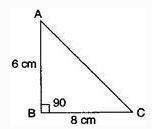Class 8 - Mathematics
Squares and Square Roots - Exercise 6.4
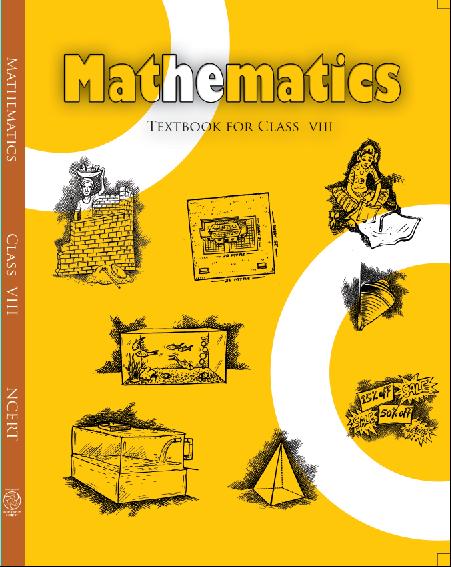
Top Block 1
Question: 1. Find the square roots of each of the following numbers by Division method:
(i) 2304 (ii) 4489
(iii) 3481 (iv) 529
(v) 3249 (vi) 1369
(vii) 5776 (viii) 7921
(ix) 576 (x) 1024
(xi) 3136 (xii) 900
(i) 2304 (ii) 4489
(iii) 3481 (iv) 529
(v) 3249 (vi) 1369
(vii) 5776 (viii) 7921
(ix) 576 (x) 1024
(xi) 3136 (xii) 900
Answer :
(i) 2304
Hence, the square root of 2304 is 48.
(i) 2304
Hence, the square root of 2304 is 48.
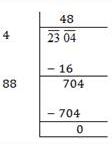
(ii) 4489
Hence, the square root of 4489 is 67.
Hence, the square root of 4489 is 67.
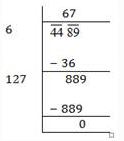
(iii) 3481
Hence, the square root of 3481 is 59.
Hence, the square root of 3481 is 59.
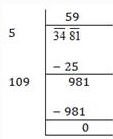
(iv) 529
Hence, the square root of 529 is 23.
Hence, the square root of 529 is 23.
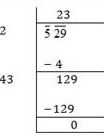
Mddle block 1
(v) 3249
Hence, the square root of 3249 is 57.
Hence, the square root of 3249 is 57.
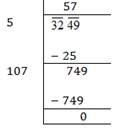
(vi) 1369
Hence, the square root of 1369 is 37.
Hence, the square root of 1369 is 37.
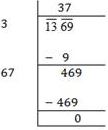
(vii) 5776
Hence, the square root of 5776 is 76.
Hence, the square root of 5776 is 76.

(viii) 7921
Hence, the square root of 7921 is 89.
Hence, the square root of 7921 is 89.
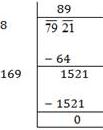
(ix) 576
Hence, the square root of 576 is 24.
Hence, the square root of 576 is 24.
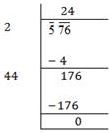
(x) 1024
Hence, the square root of 1024 is 32.
Hence, the square root of 1024 is 32.
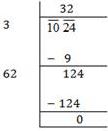
(xi) 3136
Hence, the square root of 3136 is 56.
Hence, the square root of 3136 is 56.
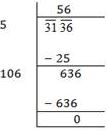
(xii) 900
Hence, the square root of 900 is 30.
Hence, the square root of 900 is 30.

Question: 2. Find the number of digits in the square root of each of the following numbers (without any calculation):
(i) 64
(ii) 144
(iii) 4489
(iv) 27225
(v) 390625
(i) 64
(ii) 144
(iii) 4489
(iv) 27225
(v) 390625
Answer :
(i) Here, 64 contains two digits which is even.
Therefore, number of digits in square root = n⁄2 = 2⁄2 = 1
(ii) Here, 144 contains three digits which is odd.
Therefore, number of digits in square root = (n + 1)⁄2 = (3 + 1)⁄2
= 4⁄2 = 2 (iii) Here, 4489 contains four digits which is even.
Therefore, number of digits in square root = n⁄2 = 4⁄2 = 2
(iv) Here, 27225 contains fivr digits which is odd.
Therefore, number of digits in square root = n⁄2 = (5 + 1)⁄2 = 3
(v) Here, 390625 contains six digits which is even.
Therefore, number of digits in square root = n⁄2 = 6⁄2 = 3
(i) Here, 64 contains two digits which is even.
Therefore, number of digits in square root = n⁄2 = 2⁄2 = 1
(ii) Here, 144 contains three digits which is odd.
Therefore, number of digits in square root = (n + 1)⁄2 = (3 + 1)⁄2
= 4⁄2 = 2 (iii) Here, 4489 contains four digits which is even.
Therefore, number of digits in square root = n⁄2 = 4⁄2 = 2
(iv) Here, 27225 contains fivr digits which is odd.
Therefore, number of digits in square root = n⁄2 = (5 + 1)⁄2 = 3
(v) Here, 390625 contains six digits which is even.
Therefore, number of digits in square root = n⁄2 = 6⁄2 = 3
Question: 3. Find the square root of the following decimal numbers:
(i) 2.56
(ii) 7.29
(iii) 51.84
(iv) 42.25
(v) 31.36
(i) 2.56
(ii) 7.29
(iii) 51.84
(iv) 42.25
(v) 31.36
Answer :
(i) 2.56
Hence, the square root of 2.56 is 1.6.
(i) 2.56
Hence, the square root of 2.56 is 1.6.

(ii) 7.29
Hence, the square root of 7.29 is 2.7.
Hence, the square root of 7.29 is 2.7.

(iii) 51.84
Hence, the square root of 51.84 is 7.2.
Hence, the square root of 51.84 is 7.2.
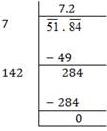
(iv) 42.25
Hence, the square root of 42.25 is 6.5.
Hence, the square root of 42.25 is 6.5.
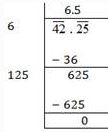
(v) 31.36
Hence, the square root of 31.36 is 5.6.
Hence, the square root of 31.36 is 5.6.
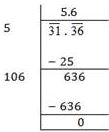
Question: 4. Find the least number which must be subtracted from each of the following numbers so as to get a perfect square. Also, find the square root of the perfect square so obtained:
(i) 402
(ii) 1989
(iii) 3250
(iv) 825
(v) 4000
(i) 402
(ii) 1989
(iii) 3250
(iv) 825
(v) 4000
Answer :
(i) 402
We know that, if we subtract the remainder from the number, we get a perfect square.
Here, we get remainder 2. Therefore 2 must be subtracted from 402 to get a perfect square.
(i) 402
We know that, if we subtract the remainder from the number, we get a perfect square.
Here, we get remainder 2. Therefore 2 must be subtracted from 402 to get a perfect square.
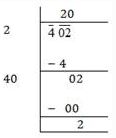
∴ 402 – 2 = 400
Hence, the square root of 400 is 20.
Hence, the square root of 400 is 20.
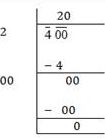
(ii) 1989
We know that, if we subtract the remainder from the number, we get a perfect square.
Here, we get remainder 53. Therefore 53must be subtracted from 1989 to get a perfect square.
We know that, if we subtract the remainder from the number, we get a perfect square.
Here, we get remainder 53. Therefore 53must be subtracted from 1989 to get a perfect square.
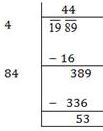
∴ 1989 – 53 = 1936
Hence, the square root of 1936 is 44.
Hence, the square root of 1936 is 44.

(iii) 3250
We know that, if we subtract the remainder from the number, we get a perfect square.
Here, we get remainder 1. Therefore 1 must be subtracted from 3250 to get a perfect square.
We know that, if we subtract the remainder from the number, we get a perfect square.
Here, we get remainder 1. Therefore 1 must be subtracted from 3250 to get a perfect square.
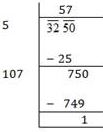
∴ 3250 – 1 = 3249
Hence, the square root of 3249 is 57.
Hence, the square root of 3249 is 57.

(iv) 825
We know that, if we subtract the remainder from the number, we get a perfect square.
Here, we get remainder 41. Therefore 41 must be subtracted from 825 to get a perfect square.
We know that, if we subtract the remainder from the number, we get a perfect square.
Here, we get remainder 41. Therefore 41 must be subtracted from 825 to get a perfect square.
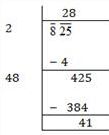
∴ 825 – 41 = 784
Hence, the square root of 784 is 28.
Hence, the square root of 784 is 28.
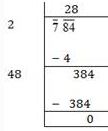
(v) 4000
We know that, if we subtract the remainder from the number, we get a perfect square.
Here, we get remainder 31. Therefore 31 must be subtracted from 4000 to get a perfect square.
We know that, if we subtract the remainder from the number, we get a perfect square.
Here, we get remainder 31. Therefore 31 must be subtracted from 4000 to get a perfect square.

∴ 4000 – 31 = 3969
Hence, the square root of 3969 is 63.
Hence, the square root of 3969 is 63.

Question: 5. Find the least number which must be added to each of the following numbers so as to get a perfect square. Also, find the square root of the perfect square so obtained:
(i) 525
(ii) 1750
(iii) 252
(iv) 1825
(v) 6412
(i) 525
(ii) 1750
(iii) 252
(iv) 1825
(v) 6412
Answer :
(i) 525
Since remainder is 41.
Therefore 22² < 525
Next perfect square number 23² = 529
Hence, number to be added
= 529 – 525 = 4
∴ 525 + 4 = 529
Hence, the square root of 529 is 23.
(i) 525
Since remainder is 41.
Therefore 22² < 525
Next perfect square number 23² = 529
Hence, number to be added
= 529 – 525 = 4
∴ 525 + 4 = 529
Hence, the square root of 529 is 23.
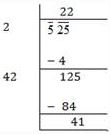
(ii) 1750
Since remainder is 69.
Therefore 41² < 1750
Next perfect square number 42² = 1764
Hence, number to be added
= 1764 – 1750 = 14
∴ 1750 + 14 = 1764
Hence, the square root of 1764 is 42.
Since remainder is 69.
Therefore 41² < 1750
Next perfect square number 42² = 1764
Hence, number to be added
= 1764 – 1750 = 14
∴ 1750 + 14 = 1764
Hence, the square root of 1764 is 42.
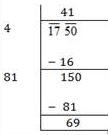
(iii) 252
Since remainder is 27.
Therefore 15² < 252
Next perfect square number 16² = 256
Hence, number to be added
= 256 – 252 = 4
∴ 252 + 4 = 256
Hence, the square root of 256 is 16.
Since remainder is 27.
Therefore 15² < 252
Next perfect square number 16² = 256
Hence, number to be added
= 256 – 252 = 4
∴ 252 + 4 = 256
Hence, the square root of 256 is 16.
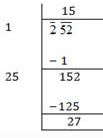
(iv) 1825
Since remainder is 61.
Therefore 42² < 1825
Next perfect square number 43² = 1849
Hence, number to be added = 1849 – 1825 = 24
∴ 1825 + 24 = 1849
Hence, the square root of 1849 is 43.
Since remainder is 61.
Therefore 42² < 1825
Next perfect square number 43² = 1849
Hence, number to be added = 1849 – 1825 = 24
∴ 1825 + 24 = 1849
Hence, the square root of 1849 is 43.
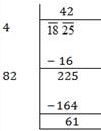
(v) 6412
Since remainder is 12.
Therefore 80² < 6412
Next perfect square number 81² = 6561
Hence, number to be added
= 6561 – 6412 = 149
∴ 6412 + 149 = 6561
Hence, the square root of 6561 is 81.
Since remainder is 12.
Therefore 80² < 6412
Next perfect square number 81² = 6561
Hence, number to be added
= 6561 – 6412 = 149
∴ 6412 + 149 = 6561
Hence, the square root of 6561 is 81.
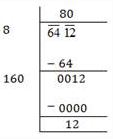
Question: 6. Find the length of the side of a square whose area is?
Answer :
Let the length of side of a square be meter.
Area of square = (side)² = x²
According to question,
Let the length of side of a square be meter.
Area of square = (side)² = x²
According to question,
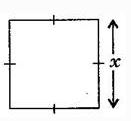
x² = 441
x = √441 = √3 x 3 x 7 x 7
= 3 x 7
= 21 m
Hence, the length of side of a square is 21 m.
x = √441 = √3 x 3 x 7 x 7
= 3 x 7
= 21 m
Hence, the length of side of a square is 21 m.
Question: 7. In a right triangle ABC, B =

(i) If AB = 6 cm, BC = 8 cm, find AC.
(ii) If AC = 13 cm, BC = 5 cm, find AB.
(ii) If AC = 13 cm, BC = 5 cm, find AB.
Answer :
(a) Using Pythagoras theorem,
AC² = AB² + BC²
AC² = 6² + 8²
AC² = 36 + 64 = 100
AC = 10 cm
(b) Using Pythagoras theorem,
AC² = AB² + BC²
169 = AB² + 25
AB² = 169 – 25
AB² = 144
AB = 12 cm
(a) Using Pythagoras theorem,
AC² = AB² + BC²
AC² = 6² + 8²
AC² = 36 + 64 = 100
AC = 10 cm
(b) Using Pythagoras theorem,
AC² = AB² + BC²
169 = AB² + 25
AB² = 169 – 25
AB² = 144
AB = 12 cm
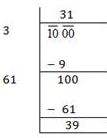
Question: 8. A gardener has 1000 plants. He wants to plant these in such a way that the number of rows and number of columns remain same. Find the minimum number of plants he needs more for this.
Answer :
Here, plants = 1000
Since remainder is 39.
Therefore 31² < 1000
Next perfect square number 32² = 1024
Hence, number to be added
= 1024 – 1000 = 24
∴ 1000 + 24 = 1024
Hence, the gardener required 24 more plants.
Here, plants = 1000
Since remainder is 39.
Therefore 31² < 1000
Next perfect square number 32² = 1024
Hence, number to be added
= 1024 – 1000 = 24
∴ 1000 + 24 = 1024
Hence, the gardener required 24 more plants.
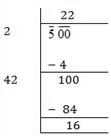
Question: 9. There are 500 children in a school. For a P.T. drill they have to stand in such a manner that the number of rows is equal to number of columns. How many children would be left out in this arrangement?
Answer :
Here, Number of children = 500
By getting the square root of this number, we get,
In each row, the number of children is 22.
And left out children are 16.
Here, Number of children = 500
By getting the square root of this number, we get,
In each row, the number of children is 22.
And left out children are 16.
